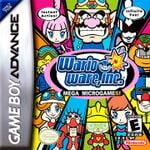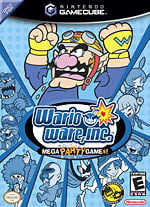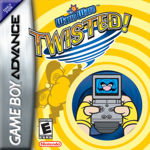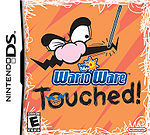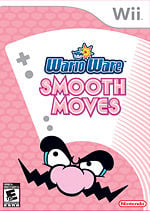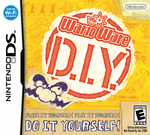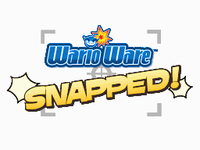WarioWare (series)
It has been requested that this article be rewritten and expanded to include more information.
Template:Articleabout Template:Series-infobox
WarioWare, sometimes WarioWare, Inc. and known as Made in Wario (メイド イン ワリオ Meido in Wario) in Japan, is a video game series published by Nintendo and mostly co-developed by Nintendo SPD Group No. 1 and Intelligent Systems. It is focused on very short and simple minigames, more specifically microgames. It was introduced in 2003 and is a spin-off of both Mario Artist: Polygon Studio and the Wario series. The concept of WarioWare was first used in the named Mario Artist title. The plot of the WarioWare series centers around its main character, Wario, and his friends who work for his "company", WarioWare, Inc., and develop the microgames.
Overview
WarioWare games have been published for every Nintendo system after 2003, and their style varies from system to system, depending on its features (e.g. for Nintendo DS, the games are based on touching the touch screen and blowing into the microphone). Each game consists of microgames (really tiny and simple games like popping balloons or spinning a coin) that are often crazy (like picking a nose). The games might seem simple, but as the player's level goes up, they become more and more challenging. This concept was first used in Mario Artist: Polygon Studio in the so-called Sound Bomber mode, but only with a very small number of microgames. Beneath the microgame stages, all WarioWare titles offer unlockable extra modes and "full" minigames.
Story-wise, the games center on Wario, his company WarioWare, Inc., and his friends in Diamond City who develop microgames for his company, though greedy Wario usually refuses to pay his friends, despite the high success of the games. WarioWare introduced several new characters, which are featured solely in these games, except for cameo appearances in Super Smash Bros. Brawl. Most games of the series include short stories in the form of cut scenes dedicated to each of the developers, telling about adventures or the everyday life of them. These cut scenes are split into two parts, the first one can be seen before the developer's respective microgame stage, while the latter part with the ending appears after the player beat the stage.
Games
This article is under construction. Therefore, please excuse its informal appearance while it is being worked on. We hope to have it completed (when it's done, it's done). Tagged in 19:24, 10 August 2014 (EDT).
Main series
| Title, Original Release and System | Synopsis and Ratings |
|---|---|
| WarioWare, Inc.: Mega Microgame$!
|
The first installment of the series, WarioWare, Inc.: Mega Microgame$! begins with Wario's starting a video game company called WarioWare, Inc., wishing to replicate the success of Pyoro. He stops working after one video game, however, so he hires his friends to make the rest of the game. Due to budget constraints, however, his friends make microgames rather than full games. After seeing the games as a success, however, Wario refuses to pay his employees and escapes, although he ultimately loses the money. WarioWare, Inc.: Mega Microgame$ introduces several characters including Jimmy T., Dribble and Spitz, Mona, 9-Volt, Orbulon, Dr. Crygor, and Kat and Ana. Each have their own story to tell, and each have a unique set of microgames styled on a theme. Also, the setting established in this game, Diamond City, is the recurring main setting in future games. |
| Template:Releasedate Game Boy Advance | Gamespot - 9.1 • Metacritic - 89 |
| WarioWare, Inc.: Mega Party Game$!
|
WarioWare, Inc.: Mega Party Game$! returns the microgames while focusing on the multiplayer aspect. There are no plots or story-themed stages, although each character is still associated with a specific theme of microgames. Each character is also associated with one of the many multiplayer modes. This game is one of Nintendo Research & Development 1's last games before most of it was transferred to Nintendo EAD and Nintendo Software Planning & Development. |
| Template:Releasedate Nintendo Gamecube | Gamespot - 7 • Metacritic - 76 |
| WarioWare: Twisted!
|
The microgames of WarioWare, Twisted! take advantage of the Gameboy Advance's tilt sensor and the rumble feature. According to the game, the feature was implemented one day when Wario was playing a game and loses. Angry, he throws the Gameboy Advance and breaks it. Dr. Crygor repairs it by placing it in the Gravitator, transforming it, and shortly after, Mona and 9-Volt enjoy the new system. Wario decides release the system into the market so he can make a fortune. WarioWare, Twisted! returns the character-specific story segments, and it is the first game that organizes the microgames around the control scheme rather than an aesthetic style. Wario-Man, an alter-ego of Wario, and 18-Volt, a friend of 9-Volt, also make a first appearance. This game has not been released in Europe. |
| Template:Releasedate Gameboy Advance | Gamespot - 8.8 • Metacritic - 88 |
| WarioWare: Touched!
|
WarioWare: Touched! uses mainly the touchscreen controls of the Nintendo DS. Wario, who has stolen a Gameboy Advance and a Gameboy Advance SP, trips and drops the two systems into a manhole. The Sewer Guru appears with the two systems and the Nintendo DS, asking Wario which one he dropped. Wario fights the Sewer Guru and takes all the systems. After figuring how the Nintendo DS works, he realizes the potential it has for profit and markets the system. WarioWare: Touched! introduces a few new characters: Ashley and Red, the Thang Family, Mike. Dr. Crygor also, from now on, has a full helmet rather than half a helmet. As in WarioWare: Twisted!, each character microgame set is based on certain controls rather than an aesthetic theme (for instance, Mona's microgames involve making slicing movements on the touch screen). |
| Template:Releasedate Nintendo DS | Gamespot - 7.2 • Metacritic - 81 |
| WarioWare: Smooth Moves
|
As with most previous WarioWare games, WarioWare: Smooth Moves relies on its system's main feature: the Nintendo Wii's motion controls. In the game, the Wii Remote is referred as the Form Baton; there are several positions the Form Baton can assume. Wario, following a Splunk that has stolen his food, ventures into the Temple of Form, where he finds the Form Baton. He triggers a trap, but he successfully escapes the cave with the treasure. Later, however, the Splunks chase Wario back to the Temple of Form, and Wario accidentally places it back where it belongs. WarioWare: Smooth Moves introduces several characters: Young Cricket and Master Mantis, Penny, the granddaughter of Dr. Crygor; Jimmy P., a Jimmy T. lookalike; and Tiny Wario. |
| Template:Releasedate Wii | Gamespot - 9.1 • Metacritic - 83 |
| WarioWare: D.I.Y.
|
WarioWare: D.I.Y. is the first WarioWare game that allows players to create their own microgames as well as play some premade microgames. After a dream where he encounters several video game characters walk out the TV, Dr. Crygor invents the Super MakerMatic 21. Wario initially mistakes the machine for another TV set, but after Dr. Crygor explains to him what it is, Wario sees the money-making potential. Wario's employees, however, dissatisfied with their work, leave his company to work for Diamond Software. Wario then hires the player to make the microgames. |
| Template:Releasedate Nintendo DS | Gamespot - 8 • Metacritic - 82 |
Spin-offs
| Title, Original Release and System | Synopsis and Ratings |
|---|---|
| Game & Wario
|
The first spinoff in the series, Game & Wario does not follow the traditional format of the WarioWare games. The typical microgames have been replaced by a set of more elaborate minigames which take advantage of the Nintendo Wii U's Gamepad, although microgames themselves do appear in one minigame. Most characters also undergo a minor redesign, with the different art style of the game. In the story, Wario sees the advertised Wii U on the television screen. Wario decides to market games for the console and invites his friends to help him. Eventually, his game, Wario's Pirates, is a success in Toy Express, but his fans mistaken him for the villain and blast him away. Wario crash lands in Club Sugar, meeting his employees, and they agree to go bowling. |
| Template:Releasedate Nintendo Wii U | Gamespot - 5 • Metacritic - 61 |
Secondary games
| Title, Original Release and System | Synopsis |
|---|---|
| Bird & Beans
|
Known as Pyoro in Europe, the DSiWare game is a remake of the minigame Pyoro and Pyoro 2, both first appearing in WarioWare Inc.: Mega Microgame$!. The game, as its remakes, features a bird Pyoro that uses its long tongue to eat beans. Beans can destroy parts of the ground, and Pyoro must avoid getting hit by them. In Pyoro 2, Pyoro spits seeds at the beans instead. |
| Template:Releasedate DSiWare | |
| Paper Airplane Chase
|
Paper Airplane Chase is DSiWare game that is a remake of the minigame Paper Plane from WarioWare, Inc.: Mega Microgame$!. There are three modes unlike in the original minigame: Endless Mode (similar to the original), Time Attack, and Race Mode. In Endless Mode, the paper plane avoids obstacles and gains points. In Time Attack, the paper plane needs to finish the course as quickly as it can. Finally, in Race Mode, two players attempt to race their paper planes. |
| Template:Releasedate DSiWare | |
| WarioWare: Snapped!
|
WarioWare: Snapped! uses the built-in camera feature of the Nintendo DSi. The player uses a built-in camera to stand-in for a character in the microgames. The player also uses this camera to win the microgames, including mimicking movements to grab objects, opening the mouth, or catching objects with the head. |
| Template:Releasedate DSiWare | |
| WarioWare: D.I.Y. Showcase
|
WarioWare: D.I.Y. Showcase is an addon WiiWare game for the Nintendo DS game WarioWare: D.I.Y.. The game allows content from WarioWAre: D.I.Y. to be used on the Wii, and it can be played even if the player does not have a copy of WarioWare: D.I.Y.. WarioWare: D.I.Y. Showcase also contains premade microgames categorized by a WarioWare character. |
| Template:Releasedate WiiWare |
Characters
Main characters
- Wario (also went through incarnations such as Wario-Man, Tiny Wario, and Captain Wario)
- Jimmy T.
- Mona
- Dribble
- Spitz
- 9-Volt
- Orbulon
- Dr. Crygor
- Kat
- Ana
- 18-Volt
- Ashley
- Red
- Mike
- Young Cricket
- Master Mantis
- Penny
- Jimmy P.
Other recurring characters
- Ken the Reporter
- Pyoro
- Manager Joe
- Mona's Animals
- Fronks
- Alien Bunnies
- 5-Volt
- The Dinosaurs
- Thang Family
- Shadow the Dog
- Sal Out
- Shuriken the Falcon
- Splunks
- Art and Deco
- Vanessa
Trivia
- A stage based on the WarioWare corporation is featured in Super Smash Bros. Brawl.
- Wario in his WarioWare outfit is seen in Wario Factory Court in Mario Power Tennis.
- All the European game covers of WarioWare are yellow, except for WarioWare, Inc.: Minigame Mania. Other regions have a different cover color for each game.

